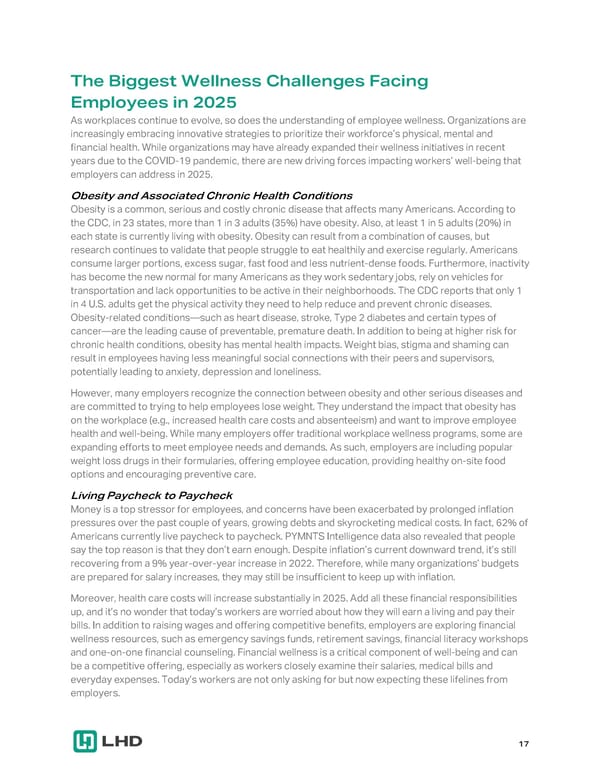The Biggest Wellness Challenges Facing Employees in 2025 As workplaces continue to evolve, so does the understanding of employee wellness. Organizations are increasingly embracing innovative strategies to prioritize their workforce’s physical, mental and financial health. While organizations may have already expanded their wellness initiatives in recent years due to the COVID-19 pandemic, there are new driving forces impacting workers’ well-being that employers can address in 2025. Obesity and Associated Chronic Health Conditions Obesity is a common, serious and costly chronic disease that affects many Americans. According to the CDC, in 23 states, more than 1 in 3 adults (35%) have obesity. Also, at least 1 in 5 adults (20%) in each state is currently living with obesity. Obesity can result from a combination of causes, but research continues to validate that people struggle to eat healthily and exercise regularly. Americans consume larger portions, excess sugar, fast food and less nutrient-dense foods. Furthermore, inactivity has become the new normal for many Americans as they work sedentary jobs, rely on vehicles for transportation and lack opportunities to be active in their neighborhoods. The CDC reports that only 1 in 4 U.S. adults get the physical activity they need to help reduce and prevent chronic diseases. Obesity-related conditions—such as heart disease, stroke, Type 2 diabetes and certain types of cancer—are the leading cause of preventable, premature death. In addition to being at higher risk for chronic health conditions, obesity has mental health impacts. Weight bias, stigma and shaming can result in employees having less meaningful social connections with their peers and supervisors, potentially leading to anxiety, depression and loneliness. However, many employers recognize the connection between obesity and other serious diseases and are committed to trying to help employees lose weight. They understand the impact that obesity has on the workplace (e.g., increased health care costs and absenteeism) and want to improve employee health and well-being. While many employers offer traditional workplace wellness programs, some are expanding efforts to meet employee needs and demands. As such, employers are including popular weight loss drugs in their formularies, offering employee education, providing healthy on-site food options and encouraging preventive care. Living Paycheck to Paycheck Money is a top stressor for employees, and concerns have been exacerbated by prolonged inflation pressures over the past couple of years, growing debts and skyrocketing medical costs. In fact, 62% of Americans currently live paycheck to paycheck. PYMNTS Intelligence data also revealed that people say the top reason is that they don’t earn enough. Despite inflation’s current downward trend, it’s still recovering from a 9% year-over-year increase in 2022. Therefore, while many organizations’ budgets are prepared for salary increases, they may still be insufficient to keep up with inflation. Moreover, health care costs will increase substantially in 2025. Add all these financial responsibilities up, and it’s no wonder that today’s workers are worried about how they will earn a living and pay their bills. In addition to raising wages and offering competitive benefits, employers are exploring financial wellness resources, such as emergency savings funds, retirement savings, financial literacy workshops and one-on-one financial counseling. Financial wellness is a critical component of well-being and can be a competitive offering, especially as workers closely examine their salaries, medical bills and everyday expenses. Today’s workers are not only asking for but now expecting these lifelines from employers. 17
 2025 Employee Benefits Market Outlook Page 16 Page 18
2025 Employee Benefits Market Outlook Page 16 Page 18